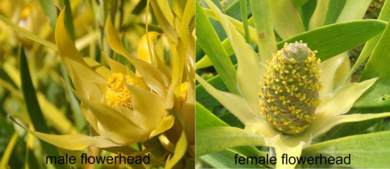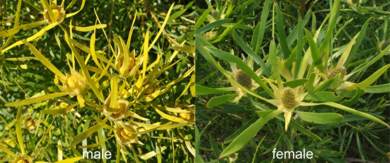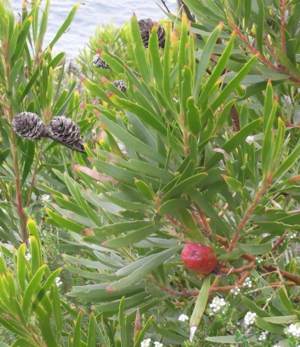Leucadendron eucalyptifolium
Leucadendron eucalyptifolium H.Buek ex Meisn.
Family: Proteaceae
Common names: gum-leaf conebush, tall conebush (English), grootgeelbos, geelbos (Afrikaans)
SA Tree No: 81
Introduction
Leucadendron eucalyptifolium is a decorative, fast-growing fynbos shrub that turns bright yellow in winter-spring.

Description
Description
A large shrub, 3-5 m tall, with a single main stem. Leaves are long and narrow, up to 105 mm long x 8 mm wide. The leaves are pointed at the tip, they narrow towards the base and are twisted through 90 degrees. The leaves around the inflorescence are longer than those growing below. Leaves are covered in soft hairs when young, and are hairless when mature.
As are all leucadendrons, Leucadendron eucalyptifolium is dioecious, meaning that male and female flowers are borne on separate plants. Flowers are borne in dense cone-like flowerheads at the branch tips. Male flowerheads are 24 mm long x 16 mm wide, cone-shaped with a soft scent. The individual flowers are deep yellow and are surrounded by bright yellow involucral bracts, which form a cup around the flowerhead, almost hiding it. The female inflorescence is 23 mm long x 12 mm wide, a silvery-green ovoid cone with small yellow flowers and a soft fruity scent. Also surrounded by bright yellow involucral bracts, but there are fewer of them than the male, so the female plants are not quite as showy as the males. Flowering season is winter to spring (July to October).

After flowering, the male flowerheads turn brown and fall off, whereas the female flowerheads persist and enlarge, growing up to 45 mm long x 20 mm wide, and becoming yellow, reddish or brownish yellow, a bright cherry red or striped red. The seeds, or more correctly the fruits, mature inside the cones, which are retained on the bushes for several years, becoming hard and woody. Seeds are winged and are released only when the cone dries out, usually after the parent plant, or branch, dies.

Conservation Status
Status
The status according to the Red list is Least Concern (LC) . Leucadendron eucalyptifolium is not threatened. Its population is stable.
Distribution and habitat
Distribution description
Leucadendron eucalyptifolium grows at forest margins and on open sandstone slopes between 160-1400 m altitude. Its distribution range is in the southern Cape, between Waboomberg and Potberg and Van Staden's Mountains, which includes the Riversdale Flats, Langeberg, Outeniqua and Tsitsikamma and Kouga Mountains, Elandsberg, Swartberg, Warmwaterberg, Touwsberg, Rooiberg, Riviersonderend Mountains and Soetwaterberg. It is most often found in sandy soils derived from sandstone. It is frequent and occurs in dense, extensive stands.
Derivation of name and historical aspects
History
The genus name Leucadendron is from the Greek leukos meaning 'white' and; dendron, 'tree'; named after the most outstanding member of the genus, the Silver Tree, Leucadendron argenteum, on which the genus was based. In the 1690s when the genus was first named it was known as the Witteboom, meaning 'white tree'. This species is named for its leaves which resemble those of the genus Eucalyptus, known as gum trees or gums.
The genus Leucadendron belongs in the protea family. It consists of 83 species, most of which occur in the Western and Eastern Cape with a few outliers in KwaZulu-Natal. They are all dioecious shrubs or trees, and are known as conebushes because the female flower heads form woody cones in which the fruits are borne.
Ecology
Ecology
Leucadendron eucalyptifolium flowers are pollinated by insects, mainly small beetles, which are attracted by the soft fruity scent.
Leucadendron eucalyptifolium is serotinous. Plants are killed by fire but their seeds are stored in woody cones on the plant for many years. After a fire, several years worth of seeds are released from the cones, and germinate en masse with the first rains. Seeds are winged and are dispersed by the wind.
Uses
Use
Leucadendron eucalyptifolium is a decorative garden plant and its foliage and flowerheads are long-lasting and can be used in floristry. The female cones are decorative when dried. This species is also the parent of the hybrid called Chameleon sold at garden centres ( Leucadendron laureolum x eucalyptifolium 'Chameleon').
Growing Leucadendron eucalyptifolium
Grow
Leucadendron eucalyptifolium grows best in a sunny position, or one where it gets sun for most of the day. It needs well-drained, sandy soil, with an acidic to neutral pH. As with most protea family shrubs, drainage, humidity and fertilising are key criteria for success: drainage must be good - proteas die in heavy soggy poorly drained soils; humidity must be low and the air must circulate- proteas are much more prone to fungal diseases where the air is hot, still and humid. Do not use manure or strong fertilisers, feed with well-rotted compost and small amounts of slow-release or organic fertilisers.
This species can be grown in containers. It is drought tolerant when established and should withstand mild frost and temperatures that dip briefly to -1° C but is not suited to very cold climates.
Grow Leucadendron eucalyptifolium in Fynbos or Mediterranean-type gardens. It is also suitable for coastal gardens, and ideal for a sunny, breezy slope. It provides winter colour and is a useful screening plant.
Propagate by seed or cuttings. Sow seeds in autumn in sterile, well-drained soil, cover with clean sand or fine-milled bark and keep moist but not wet. Seeds germinate in 4-8 weeks. Treating the seed with a fungicide increases the number of surviving seedlings. Transplant into individual containers filled with well-drained, acidic soil mix as soon as the first pair of true leaves has developed. Grow on for a year before planting out into the garden. Leucadendron eucalyptifolium is fast growing and should flower in 2 years from seed.
Take semi-hardwood cuttings from the current season's growth, in autumn or spring. Remove the leaves from the basal third of the cutting, treat with a rooting hormone, and place in awell-drained rooting medium under intermittent mist with bottom heat of 24 °C. Rooting takes about 6 weeks; harden off for 3 weeks and transplant into individual containers.
References
- Goldblatt, P. & Manning, J. 2000. Cape Plants. A conspectus of the Cape flora of South Africa. Strelitzia 9. National Botanical Institute, Pretoria & Missouri Botanical Garden, Missouri.
- Rebelo, A.G. et al. 2006. Leucadendron eucalyptifolium H.Buek ex Meisn. National Assessment: Red List of South African Plants version 2014.1. Accessed on 2014/08/05
- Rebelo, A.G. 2001. Proteas. A field guide to the proteas of southern Africa, edn 2. Fernwood Press, Vlaeberg, Cape Town.
- Vogts, M. 1989. South Africa’s Proteaceae. Know them and grow them. Struik Publishers, Cape Town.
Credits
Alice Notten
Kirstenbosch National Botanical Garden
September 2014
Plant Attributes:
Plant Type: Shrub
SA Distribution: Western Cape
Soil type: Sandy, Loam
Flowering season: Spring, Winter
PH: Acid, Neutral
Flower colour: Yellow
Aspect: Full Sun
Gardening skill: Average
Special Features:
Horticultural zones











Rate this article
Article well written and informative
Rate this plant
Is this an interesting plant?
Login to add your Comment
Back to topNot registered yet? Click here to register.